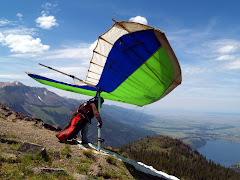 This Saturday was another short flight of just under a half hour, but I can't complain since the season usually doesn't start until March. We did get to try the new north launch, which worked brilliantly, and got to drive up the newly-maintained road (Thanks, BLM!). It also gave me a chance to scare off those rogue beavers which keep taking out the dangerous snags at midlaunch, but not before they managed to gnaw down the last two remaining snags.
This Saturday was another short flight of just under a half hour, but I can't complain since the season usually doesn't start until March. We did get to try the new north launch, which worked brilliantly, and got to drive up the newly-maintained road (Thanks, BLM!). It also gave me a chance to scare off those rogue beavers which keep taking out the dangerous snags at midlaunch, but not before they managed to gnaw down the last two remaining snags. Since I got to the lz a little early, I decided to buzz by a fellow pilot's house to pick up a glider that he'd graciously donated to the cause of replentishing the local hang glider pilot population. It's a Moyes Something-or-other (the placard was missing), and it's in pretty good shape. If anyone recognizes this particular model of single-surface wing, please let me know. As far as I can figure, it's sail area is about 182 square feet, so it'll work good for bigger pilots. Thanks again, John, for the donation!
Since I got to the lz a little early, I decided to buzz by a fellow pilot's house to pick up a glider that he'd graciously donated to the cause of replentishing the local hang glider pilot population. It's a Moyes Something-or-other (the placard was missing), and it's in pretty good shape. If anyone recognizes this particular model of single-surface wing, please let me know. As far as I can figure, it's sail area is about 182 square feet, so it'll work good for bigger pilots. Thanks again, John, for the donation! Last year for our annual Starthistle Fly-in, I was responsible for designing the t-shirt art, theme development, events, and awards. It's a lot to do, especially to a full-timer like me, so I decided to get a jump on making the trophies for this year. Last year I sculpted, formed, and cast a dozen figurines to mount on plaques. Having never worked with casting before, there was a bit of a learning curve, but I was pretty happy with the results. The figurines are of the club mascot, Woody the Woodrat, with his head poking through a carabiner. Woodrat is the name of the mountain that we fly and the carabiner is what suspends us from our wings. The original design actually came about several years ago when gliders like the trainer above were the cutting-edge ships. Nowdays, if anyone was seen setting up one of those old gliders to fly off the top of Woodrat Mtn., their sanity would be questioned. They're great for the training hill though.
Last year for our annual Starthistle Fly-in, I was responsible for designing the t-shirt art, theme development, events, and awards. It's a lot to do, especially to a full-timer like me, so I decided to get a jump on making the trophies for this year. Last year I sculpted, formed, and cast a dozen figurines to mount on plaques. Having never worked with casting before, there was a bit of a learning curve, but I was pretty happy with the results. The figurines are of the club mascot, Woody the Woodrat, with his head poking through a carabiner. Woodrat is the name of the mountain that we fly and the carabiner is what suspends us from our wings. The original design actually came about several years ago when gliders like the trainer above were the cutting-edge ships. Nowdays, if anyone was seen setting up one of those old gliders to fly off the top of Woodrat Mtn., their sanity would be questioned. They're great for the training hill though. Anyway, the way I made the figurines was by sculpting an original out of Sculpy clay, coating it with several coats of latex, and using the latex mold to make plaster casts. What I didn't do last time that I should have was to make a 'mother mold' so that the latex mold wouldn't deform while the plaster was curing. I did that this time, and the result was a dozen very similar figurines without the slight variations in shape that resulted last year.
Anyway, the way I made the figurines was by sculpting an original out of Sculpy clay, coating it with several coats of latex, and using the latex mold to make plaster casts. What I didn't do last time that I should have was to make a 'mother mold' so that the latex mold wouldn't deform while the plaster was curing. I did that this time, and the result was a dozen very similar figurines without the slight variations in shape that resulted last year. 
Now I have twelve nearly identical plaster figurines sanded and ready to paint. The hard and messy part is done.



